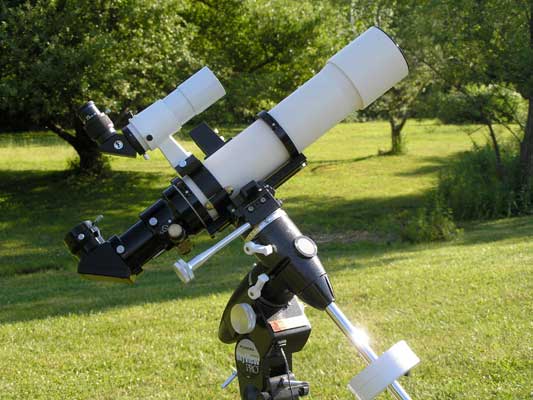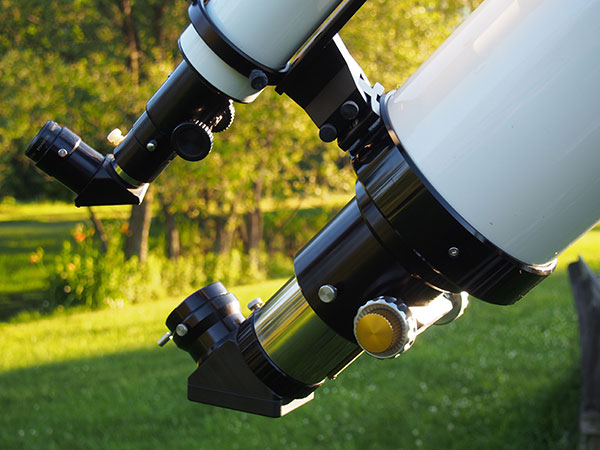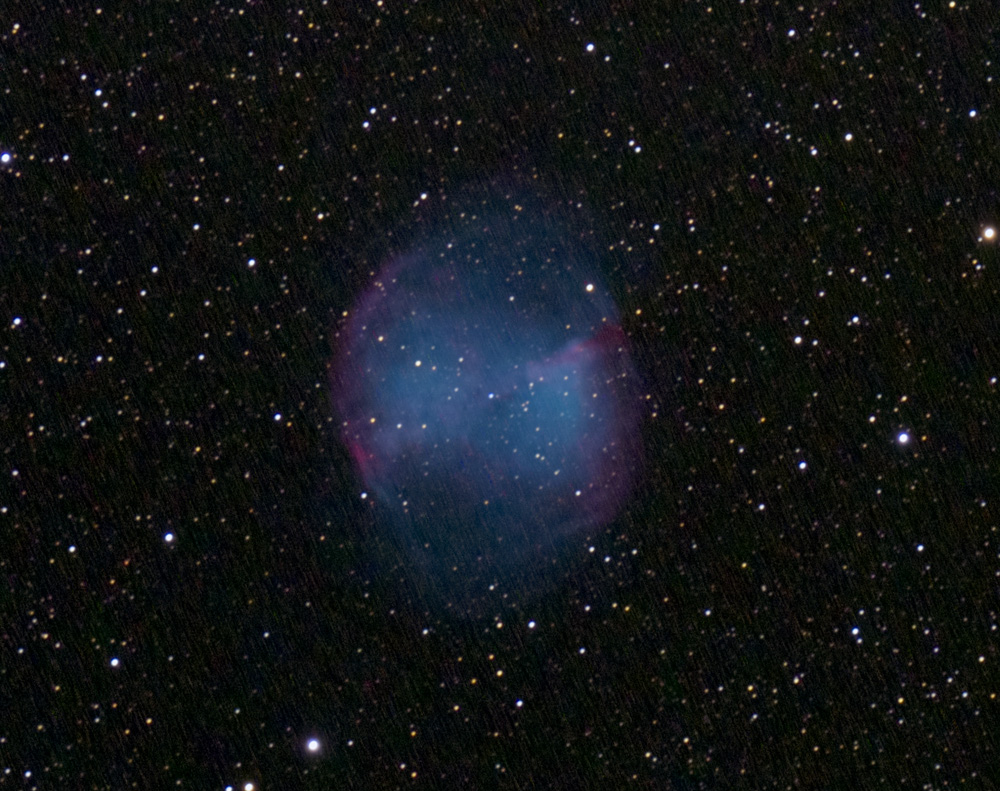|
Joe Bergeron's Astro-Physics Page
Astro-Physics
is a singular force in the little
world of amateur astronomy equipment. Roland and
Marjorie Christen, its owners (with Roland as
chief designer and optician) have become legendary
figures, though neither is especially intimidating
in person. They and their company are responsible
for a good part of the telescope landscape of
today. The ongoing boom in refractors of all kinds
can largely be traced to Roland's pioneering
affordable triplets. Today's A-P telescopes are
less affordable, but are much more refined than
those early scopes, and in such demand that it's
impossible to call their shop and order a new
instrument without first waiting many years for
the chance to do so. To take up this slack,
several other makers of comparable telescopes have
arisen. I've
purchased four A-P refractors over the years. I
was able to get most of them with insignificant
waits
compared to what people face now. My secret? I
became aware of their products and started buying
them almost from the beginning, well before the
current craze which has led more than one
frustrated would-be buyer to lament his bad
fortune and circulate bitter opinions about A-P's
business practices. As more and more A-P scopes
reached the field, enabling stargazers to see and
appreciate what a fine refractor of substantial
aperture could do, interest built up, until by the
late 90s those infamous waiting lists began to
lengthen, necessitated by Roland's finite time for
figuring lenses and his unwillingness to
compromise the process.
It's
worth remembering where refractors stood in the
telescope marketplace of the 70s and early 80s.
Briefly put, you rarely saw them. The scopes in
use by serious observers and photographers were
Newtonians and Schmidt-Cassegrains. Refractors
were limited to long-focus beginner scopes of
three inches and below, many of dubious quality,
most of them sold through catalogs and department
stores. Larger ones were rare, and color-free
apochromats almost non-existent except for
extremely expensive fluorite scopes from
Takahashi. Amateurs desiring larger refractors had
few options. They could get anything up to a 6"
f/15 (with a tube eight feet long) from the A.
Jaegers company, but they had to assemble it
themselves. They could buy a 4" Unitron for a
large sum, or even a 5" or a 6" if they controlled
vast personal wealth. Otherwise, there were few
choices. Astrophotographers found such scopes
largely useless. Only a masochist would photograph
deep-sky targets at f/15, and faster scopes were
plagued with chromatic aberration. My adventure with Astro-Physics began in 1985 when I saw their early advertisements for refractors, which were followed by Richard Berry's review of the original 6-inch f/8 in Astronomy Magazine. At the time I had reflectors of 6, 8, and 10-inch aperture, plus a C-8. But I had started my career as an amateur astronomer with small achromatic refractors. Something about those elegant instruments had always appealed to me. A compact, 6-inch, color-free version promised something like a perfect telescope, that chimerical Holy Grail pursued by many a guy like me. This was back when a complete, mounted 6-inch could be had for $2450. To finance the purchase, I sold the C-8 and the 6 and 10-inch reflectors, hoping their functions could be taken over by the refractor. When the scope finally showed up (about seven months after ordering), the first thing that struck me was its imposing, commanding size. Its height exceeded my own! The second thing was the detail I could see on Mars, then just past a fine opposition. The third thing was how much chromatic aberration I saw. It had quite a bit...more than I thought was appropriate for an "apochromatic" telescope. I also found the claims for its performance were exaggerated. Rather than offering "planetary performance that puts 12-inch reflectors to shame", it behaved according to the laws of physics rather than those of magic, being comparable to my 8-inch Newt in terms of what it could actually show.
Nevertheless,
when
the opportunity came to upgrade to the new
6-inch f/9 StarFire design, I took it,
though I hated to see the original scope go.
The new scope showed false color only on the
brightest stars. The moon and planets were
now shown in their natural colors. As an
artist, that came as a relief to me. Pluto
was easy to spot in this telescope. I
eventually found myself wanting a more
sophisticated mount. Although the
Astro-Physics products were vastly improved
over the old 706, they were also vastly more
expensive. I compromised a bit, buying one
of the first Losmandy G-11 mounts, an
excellent, relatively inexpensive mount.
While not exactly rock steady with a
refractor of this length, it's fine for
visual use as long as the wind is minimal.
Any guided astrophotography would be a
challenge with this combination. The A-P
1100 mount would be preferable, but it costs
more than what I paid for all three of my 6"
refractors combined! I keep putting myself
on the waiting list for these mounts, but
then I keep turning them down, since I do
not yet possess enormous wealth. A
few years later, Roland introduced the EDT
telescopes. At the 1993 Winter Star Party, a
friend of mine brought his 6-inch StarFire,
the same model as mine, while next door was
a new EDT of the same size and focal ratio.
I sauntered over to this scope, confident
that the new glass could not produce a
noticeable improvement over the StarFire.
But to my horror and chagrin, I found the
images in the EDT were a bit tighter and
more contrasty than those in the older
StarFire. Worse, while observing Jupiter, I
found that in comparing the two scopes, I
could now discern a slight violet haze
surrounding the planet in the StarFire!
Falling prey to the same perfectionistic
quest for incremental improvements that
fells many other amateurs, I soon put in an
order for my own 155mm f/9 EDT. Buying it at
the steep price of $3,200 was a stretch for
me, even after selling the StarFire for a
bit more than I paid for it. I bet many of
my readers wish they could call A-P now and
order a new 155mm refractor for $3,200! I
got it just in time for the SL-9 crash on
Jupiter. I believe it was the last f/9 made.
It immediately struck me as the most perfect
telescope I had ever owned. It showed no
false color whatsoever, even on Sirius at
high power. Images were otherwise flawless
as well. This was the first telescope I ever
owned which I could use without ever
questioning its optical performance, which
is a great luxury. When I observe with it, I
concentrate on the object, and not the
telescope. I always know it's delivering the
finest image that can be had for its
aperture. It's a comfort and a pleasure to
use such an instrument. 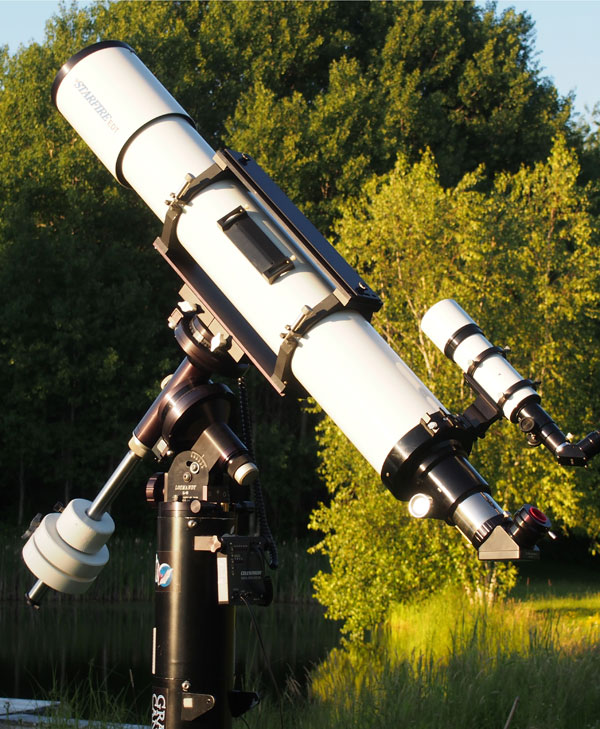 In the
spring of 2002 I underwent one of those
squirmy little fits of dissatisfaction which
sometimes afflict amateur astronomers. In my
case I was bugged by the smallness and color
of my trusty little TeleVue Pronto. I started
thinking about the TeleVue 85. Then, like a
miracle, my name came up on the AP waiting
list for the most hallowed of all small
scopes, the 92mm Stowaway. This avatar of the
rare original model is f/6.6 instead of f/4.8.
Although it was expensive (almost as much as
what I paid for my 155 EDT), I decided to
splurge, knowing that I should at least be
able to get my money back out of it, barring
the total collapse of the economy. In the
spring of 2002 I underwent one of those
squirmy little fits of dissatisfaction which
sometimes afflict amateur astronomers. In my
case I was bugged by the smallness and color
of my trusty little TeleVue Pronto. I started
thinking about the TeleVue 85. Then, like a
miracle, my name came up on the AP waiting
list for the most hallowed of all small
scopes, the 92mm Stowaway. This avatar of the
rare original model is f/6.6 instead of f/4.8.
Although it was expensive (almost as much as
what I paid for my 155 EDT), I decided to
splurge, knowing that I should at least be
able to get my money back out of it, barring
the total collapse of the economy.
The scope arrived at the end of July 2002, and of course it is truly a jewel. Here's my initial assessment as written to Roland: The weather here for the past two nights has been soupy and humid, so conditions have been poor for deep-sky objects. However, the seeing is nearly perfect, giving me a good chance to check out the Stowaway. I'm not an expert star tester, but I'm unable to see any real difference between the in-and-out of focus star images at 180X. When racked out to show a few Fresnel rings the patterns are crisp, perfect, and identical on either side. In focus, the stars are awesome Airy disks with one or two delicate diffraction rings. Double star performance is all that I could want. At RTMC this year, Roger Ceragioli, an optician from the University of Arizona Mirror Lab, brought a 90mm triplet apochromat he had made, about f/11 (he was the same guy who star tested my 155mm EDT at the Grand Canyon recently). Anyway, I looked at Epsilon Bootis through it and was most impressed with the clean split. My Questar never does as well. It always blends the secondary into the bright first diffraction ring. Well, the Stowaway handled the star as beautifully as Roger's scope. It also delivered a clean, pretty split on Delta Cygni. On Nu Scorpii, it cleanly split the fainter pair, and elongated the brighter, closer pair, which I believe is about 1". I have looked at a few DSOs, but will have to await a better night to do much with them. I did get some resolution of M5, and quite good resolution of M13. The sky was so murky I could barely even see M4. It will be good to get this scope back to the California desert. Now, I said I wasn't going to complain about color error, and I'm not. I am going to comment on it though. I was surprised that when viewing Vega at 180X I could just see the merest ghost of a violet halo around it. When I focused in a bit I saw a faint violet fringe, and when I focused out I saw a faint yellow-green one. I do not consider
this to be a problem, as it will never be
obtrusive. I was surprised though because
I've never seen any color, in or out of
focus, or under any circumstances, in my
155. I figured that a smaller scope with
similar glasses would be the same, even if
it does have a shorter focal ratio. Go
figure.
Mechanically I like most aspects of the scope. The two-speed focuser is cool. I initially had reservations about the rings and slide bar arrangement, but I find it works pretty well on my Telepod head. I do think it would be better if the rings could be quickly loosened by hand to facilitate balance changes. The TeleVue tube ring is great in this regard. I am puzzled by the dew cap...it's so short, sticking out only about two inches in front of the lens. If you're going to provide this elaborate sliding baffled dewcap, which spends most of its time retracted and adds almost no bulk, why not make it twice as long? I can't believe it's going to be very effective as a dew cap, and hauling Kendrick stuff around with it would be a hassle. I also think there should be some provision for adding a finder or a sighter of some kind. I really wanted to add a Starbeam, but if I did I suppose it wouldn't fit in the case anymore. I have stuck a Rigel Quikfinder on it. Yes, not very aesthetic, but at least it's not a Telrad. Oh...the case is great, very practical and well thought out. When I got the scope it looked huge, being used to Prontos, but it seems to be shrinking as I look at it. It is as heavy as I'd want to carry through an airport though. So I'm glad it's not a Traveler. Roland
replied
with an interesting comparison of the two
objectives that explained the difference in
color correction on the Stowaway. Since
then
I've been ever more impressed by the
capabilities of the Stowaway. It's the
closest thing to a magic telescope I've ever
seen. I often find it hard to believe how
small it is when I'm confronted with the
beauty and the perfection of the views it
provides. You can read an even more
obsessively detailed review of it here.
Moon shot through
92mm Stowaway with afocal Olympus digital
camera, November 2002
Here are excerpts from other letters I've written to Astro-Physics about the performance of these telescopes: 6-inch f/8 I want to tell you about the great time I had viewing the Saturn-28 Sagittarii occultation with my 6" f/8. Considering the way the weather has been, it's miraculous that we had a string of three superb nights including July 2-3. We had dry air and very good seeing, even at Saturn's low altitude. The 6" gave probably the best view of Saturn I've ever seen, equal to what I saw with the 12" Zeiss refractor at the Griffith Observatory. At 250x, the image was crisp and flawless. It was one of the very few times I've come close to forgetting the optics and seeing only the actual object floating before me. The only thing that gave away the illusion was the Airy disk and diffraction ring of 28 Sagittarii. The Encke division was unmistakable during the best moments, a black hairline in the ansae of the A ring. The globe was very delicately shaded and detailed. During the occultation, the star was visible throughout its passage behind the A ring. It even faded in and out a few times as it passed behind the planet itself. It was extremely gratifying to observe this rare event with such a wonderful set of optics. 6-inch f/8 We recently had a public star party here at Morehead where three telescopes were in use: a C-8, a 24-inch Boller & Chivens cassegrain, and my 6" f/8. We looked at the Moon and a number of deep-sky objects. The refractor impressed most people as the best telescope there. It was hard to explain why the view through it was so much nicer than what they saw through the big light-bucket in the dome (the 24"). I was surprised how good a view of M42 I was able to provide despite the moonlit semi-urban skies...at 50x, with a UHC filter, the delicate winglike extensions were beautiful. For what it's worth, a few people remarked on the purple glow surrounding stars like Rigel and Sirius. I told them it was a defect of the telescope, but they liked it anyway because they thought it was pretty. Maybe I should have thrown it out of focus to make it even prettier for them! 6-inch f/8 For years I've been trying to make Antares look like something besides a sparkly red glob of light with a greenish area on one side. I knew it would take a combination of excellent seeing and a good-sized telescope capable of imaging stars perfectly. I now have the telescope, and I got the seeing in March at about 5 AM. At 300x, I finally got a clear view of the companion of Antares as a separate bit of light, just the merest fleck, but definitely separated. I think it would be pretty easy if Antares ever attained much altitude... I've tried other tricky double stars too, with excellent results. One example is Eta Coronae Borealis, mags 5.6 and 5.9 at 0.97", perfectly and neatly split. The star has a companion, mag 12.6, 66" north, which I saw fairly easily at 150x, although the sky transparency was fair at best that night. I've had some pretty good deep-sky views with the 6" too. M13 at 150x is a starry mass throwing spidery arms of stars off in all directions. The brightest of the individual stars are bright enough to hold with direct vision. Also at 150x, the Ring Nebula is big and intensely bright, with a pearly center and a hint of green color. 6-inch f/8 Morehead Planetarium sponsored two observing sessions for Comet Bradfield this past weekend, and I set up my 6" f/8 both times. A number of other scopes were present, including a C-8, a Meade 2080, and a 13" Odyssey. The Great Refractor ruled the evening like a queen rules over the serfs. Bradfield was distinctly brighter in the SCTs at the same power, but in image quality and mechanical stability they couldn't touch the refractor, especially when it came to observing Jupiter. The seeing was very calm both nights, and the detail visible at 200x and 240x was essentially infinite during the moments of perfect stability. There's a long white streak in the SEB that seems to wrap about halfway around the planet, and the Red Spot with its hollow are prominent. Many spots, festoons, and minor belts were seen too. The guy with the 2080 was blown away by the refractor's performance. He hung around for hours looking at Jupiter and deep-sky objects through it. He was amazed when I identified the Jovian moons by their disk sizes and general appearance. As for stability, the refractor was doing its usual Rock of Gibraltar imitation, while both SCTs did the hula if brushed by eyelashes. I also found the North America nebula for another (inexperienced) observer using his 13" Odyssey and my UHC filter. It was easy to see, but I didn't think it was much more conspicuous than it is in the 6". A smaller high-contrast telescope is just as good as some monster for looking at dim, huge nebulae, at least if you use a low enough power to keep the same exit pupil size (I prefer about 5mm). I'm gradually learning
some important lessons about this telescope.
For one thing, the degree of color error it
shows is extremely dependent on the scope's
thermal stability. If it has to cool 20° or
so, it can show a colorful image for more
than an hour, but then it undergoes a rapid,
almost sudden, improvement. Jupiter's color
error has always bothered me most, but last
weekend, the violet glow was very subtle
once it had settled down. It was, I'm happy
to say, negligible. I have really come to
regard this telescope as a treasure over the
past few months.
A few weeks ago I looked at Gamma Andromedae B at 300X with good seeing. I distinctly saw the star, with its 0.5" separation, as a "figure eight" of two merged but discrete star images. One thing that lent credibility to this observation was that I noticed the two images weren't the same size, though at the time I had the mistaken idea they were of equal magnitude. I was also impressed with the purity of color of the star when slightly defocused...it was deep indigo, in contrast with the golden primary. Deep-sky objects: I recently had a very fine look at the Veil Nebula with 38X through a UHC nebula filter (it was also visible without the filter). The section involved with 52 Cygni terminates in an impressive, hard-edged, scimitar-like spike. The whole nebula had plenty of thready, twisted detail. I only had a minute to look before clouds rolled in. To my surprise, I could still see the nebula through thin clouds that blotted out the dimmer stars. I looked at the Trapezium at 200x. Knowing there are more than four stars there, I searched and easily spotted 2 more. They turned out to be mag 11, so no great feat to pick up. But they were still something I'd never noticed before. 6-inch StarFire Just thought you might like to hear about the Grand Canyon Star Party which I attended at the beginning of the month. I crammed the 6" StarFire into my Celica and had it as my constant and intimate companion throughout my 5 1/2 week trip. At the star party it was set up in company with Newtonians and SCTs ranging in size from 17.5 " down to 6". Hundreds of people came through. I usually had the StarFire aimed at Jupiter. Many people were surprised that such a relatively small instrument so outperformed the big guys on the planet. After the planet got too low I went for deep sky objects, where the competition from the mirrors was keener. Nevertheless, I was able to impress some guys from Australia with views of the Veil, North America, etc. Actually, "impress" is too weak a word. One of those characters was practically going into spasms of envy. I told him that if I could afford a StarFire, anybody could; he replied that I obviously didn't live in Australia. 6-inch StarFire I'm often gratified at the views it provides of even some fairly obscure deep sky objects. For example, the globular cluster NGC 6712 in Scutum is large, bright, and surprisingly well-resolved at 160x. Right next to it, the planetary IC 1298 is a big, easy puff of grey light. They both fit easily into the star-spangled field of a 22mm Panoptic. 6-inch StarFire My StarFire beat Cornell's 12" f/15 Fecker refractor on Saturn! The Fecker had terrible color...the planet and rings were very yellow, surrounded by an intense violet-red glow. The image was a trifle fuzzy, and had lower contrast and slightly less detail. Only the faint moons were better seen. This was with really solid seeing, too. The 6", on the other hand, was razor-sharp, color free, and just showed more, including the Encke gap in the ansae of the rings, which I didn't see with the 12". You should have seen the puzzled looks on the faces of the visitors when they tried to figure out why my (relatively) tiny telescope gave a better view than the jumbo cannon in the dome. It was all I could do not to smugly smirk. It was more than I could do, actually.
The first thing I got a good look at was Jupiter, and I must say my jaw dropped at the sight of it. I caught it at dusk, when the seeing was steadiest and the brilliance of the disk not too overwhelming. It looked like a drawing done with Prismacolor pencils, the belts intricately inscribed in shades of umber. I've seen white ovals, dark rods, arches and festoons. I don't think I've seen anything that couldn't be seen with the (6-inch f/9 StarFire), but I do see a slight improvement in contrast and color rendering. Naturally, I then examined the fiendish star Vega to see just what kind of telescope I have here. At 210X it's like looking at the star through a perfect unobstructed reflector...there's no trace of color except the star's natural pale electric blue. The near-focus images are much more symmetrical on either side of focus than the old StarFire's were... The focused image is clearly superior. With the old scope, focus on brilliant stars was rather ambiguous...it tended to "mush" through focus on something as bright as Vega. Focus is much more decisive with the EDT. You don't have to guess which point is best. Also, the diffraction rings are different. With the old scope, I usually saw 8-10 diffraction rings surrounding brilliant stars. I never quite understood why there were so many. With the EDT, so far I've seen no more than 2, a bright inner one and a much fainter second one. Vega at a medium power is like nothing I've ever seen...a brilliant point of astonishing purity on a truly black background. It's gorgeous, worth looking at for its own sake. With that out of the way, I started doing some actual observing. I looked at Zeta Herculis, one of the toughest doubles I know, a close unequal pair. I could split it with the old sixes, albeit barely. But the EDT let me clearly separate the stars for the first time and get a good look at the secondary. I used 300X and 600X for that. It was the first time I ever actually used 600X to observe anything. Other than that, I looked at a good assortment of deep-sky objects, including NGC 6572, a tiny planetary in Ophiuchus. In a 22mm Panoptic it was startling, like a bit of sunlit turquoise floating in the field. I looked at the faint galaxy 6384 in Oph, the Crescent Nebula 6888 in Cygnus (which is a full oval with a UHC filter), and a bunch of other stuff. With this purchase my obsessive quest to obtain the ultimate 6" telescope comes to an end. I sometimes reflect (or should I say refract) on the logic of devoting so much money to a 6" telescope, when for the same money I could be looking through an excellent 18" reflector. If I lived in an area with really dark, steady skies, I'd prefer the reflector. But when I'm sitting beneath the skies we actually get out here, I'm happy to be using an Astro-Physics refractor. Even when I had a really nice 14.5" reflector, I used the StarFire more than half the time. It is amazing and gratifying to see what is visible in a 6" if you take the trouble to look. 155mm EDT It seems that I got my EDT just in time! Who could possibly have foreseen the unprecedented observing opportunity provided by S-L 9? July 19 was stunning, my first good chance to see much due to the haze and bad seeing. As soon as I sighted Jupiter in the 155 EDT I instantly saw a black spot far in the south-at 45X! Going to 210X I was presented with a view such as I never imagined I'd see in my lifetime-3 huge impact sites marching across Jupiter's SPZ. K was about to move off the disk and looked like a black dent in the limb. The biggest spot, the then-newly-formed L, was near the meridian, and was colossal, in the GRS league. The third spot, G, was almost as large and had only recently come into view. My view of the L and G spots improved as they straddled the meridian, looking like eyespots on some microorganism. Both had tiny, sharp, black cores offset toward the following edge. The overall appearance of both spots was a dark, soft-edged dusky grey. L was outlined or defined on its preceding edge by a darker comma-shaped semicircle. The tiny cores certainly added to their eyelike appearance. 92mm Stowaway
I just wanted you to know about the Stowaway's public debut at Stellafane, which on Saturday night was about as clear and crisp as it gets there. It was the first really dark night the Stowaway has seen. It performed as well as I could hope for or expect. The cluster NGC 7789 in Cassiopeia was a beautiful, finely resolved cloud of stars at 50X. The bright arc of the Veil filled the field with detail with the help of a UHC filter. Comet Hoenig was an easy, slightly mottled glow, looking almost as good as it did in a nearby 10" Dob of uncertain parentage. At 28X the Milky Way showed masses of starry mist riddled with dark intrusions. Sue French even showed me her Toadstool Cluster, French 1. I look forward to further exploring the limits of this scope back in CA. It's certainly gratifying to have that much scope in a case that small. The scope is so unobtrusive that few people noticed it or knew what it was. I considered jumping up and down and shouting, but finally decided that privacy was good too. 155mm EDT I recently returned from the Grand Canyon Star Party, where for a week of crystal-clear nights my 155 EDT was set up for public use beneath dark skies. On one night of very fine seeing Roger Ceragioli, an optician from the Mirror Lab at the U of A, came by and asked if he could star test the scope. I said sure, being pretty confident there was nothing grossly wrong with it. He fiddled around for a while and finally announced he had discovered slight over or undercorrection (he couldn't remember which it was). I saw what he meant, with the Fresnel rings being slightly less well defined on one side of focus than the other. He forebore to try to put a wavefront number on the error, but called it "unimportant but not trivial". He also detected the "tertiary spectrum", but I didn't see what he meant there. Being a pair of double star fans, we then examined a number of them, and what a pleasure that was. Antares just stood there with its companion rendered as a perfectly clear Airy disk. You could just sit there and stare at it. Nu Scorpii was also perfectly shown as four delicate Airy discs. Delta Cygni was also perfect, while Zeta Bootis, which I believe is closing, was barely resolved at 400X or so. After that, Roger pronounced it an "exquisite" objective. Even with Jupiter as low
as it was, I was able to provide sharp
views, often following it all the way down
into the trees before giving up on it. Most
visitors proclaimed it the best view of the
planet available, and it had stiff
competition in the form of numerous bigger
scopes. A fair number said similar things
about the deep-sky views, referring to them
as "clearer" than what they were seeing
elsewhere. One night later in the week the
Moon was revealing jaw-dropping detail. I
wished I could just stare at it myself, but
the lines of tourists were long. 92mm Stowaway With the seeing very
good last night I decided it was time for a
definitive showdown between the venerable
89mm Questar and that promising upstart the
f/6.6 92mm Stowaway. The Q starts out with a
3% aperture disadvantage, but that's not
enough to explain the fact that it was
whomped, stomped, and tromped by the
Stowaway. 92mm Stowaway
and 155mm EDT Last weekend was
gorgeous here, so I was out on two nights
with the 155mm. It was my first time
splitting Gamma Virginis (Porrima) since it
started to open up again. It's now at about
0.8". Despite crappy seeing at its low
altitude, I was usually able to see two
little balls touching each other at powers
of around 400X. I also looked at Eta
Geminorum (Propus), which has the reputation
of being tough. The close unequal pair was
pretty easy at around 300X, reminding me of
a dimmer, closer version of Antares and its
companion. I earlier tried this pair from
Florida with the Stowaway, but got nowhere
with that aperture. The most fun I had last
weekend was looking at the moon with my
binoviewer. The detail I saw everywhere at
230x was stunning. Among the things that
particularly caught my eyes were the
hairlike shadow cast by the Cauchy fault,
the U-shaped mountain range inside the
crater Fabricius, the rilles near Plinius
which seem to run along a low, broad
swelling on the mare, and the strange buried
crater Lamont. Imaging: In former years,
discriminating amateur astronomers would
often ask me if I used my Astro-Physics
scopes for imaging, and I would brightly
reply "Nope! I just look at stuff through
'em!" They would then slink away, muttering
and shaking their heads in sad
disappointment at this terrible and foolish
waste. The next time someone
asks, I'll be able to assure them that I do
often use these telescopes as God intended,
to image deep sky objects. So far my efforts
are at a journeyman level, as can be seen
from the image below of M27, the Dumbbell
Nebula, taken with the 155mm EDT at f/9. As
opportunity permits, I hope to improve my
technique and results. Addendum: Age and illness made
transporting and setting up the 155mm EDT
impractical, so I sold it after 30 years of
ownership. I will miss it for whatever time
remains to me.
|
 |
|
|
Words and images copyright by Joe Bergeron.
 |
 |
 |
 |
 |
 |
 |
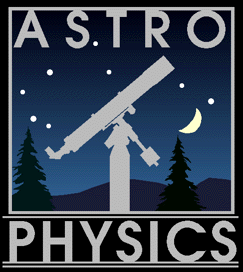
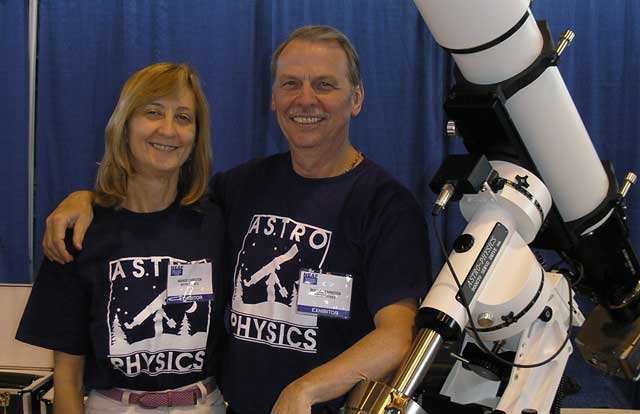
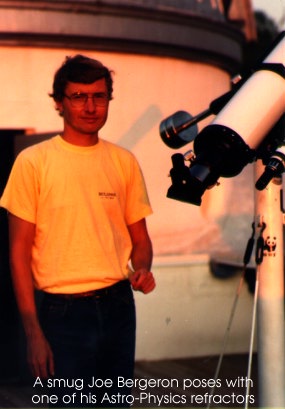 Thus
began a lengthy love-hate relationship with
this telescope. Roland received a stream of
peevish complaints. For months I spent more
of my viewing time agonizing over the color
than actually looking at and appreciating
anything. But as time passed I was won over
by the exquisite things I saw through this
instrument. Star images were much more
perfect and stable than those offered by my
reflectors. Once set up, the telescope
worked almost at once, with little cool-down
time needed, and none for collimation. The
706 mount was extremely solid, if not very
fancy. I saw Gamma Andromedae B as a notched
figure-8. I saw stars down to magnitude
14.7. The view of the Saturn occultation of
28 Sagittarii was glorious. Eventually the
color error, which tended to improve as the
scope fully stabilized, came to seem
unimportant, or at least tolerable.
Thus
began a lengthy love-hate relationship with
this telescope. Roland received a stream of
peevish complaints. For months I spent more
of my viewing time agonizing over the color
than actually looking at and appreciating
anything. But as time passed I was won over
by the exquisite things I saw through this
instrument. Star images were much more
perfect and stable than those offered by my
reflectors. Once set up, the telescope
worked almost at once, with little cool-down
time needed, and none for collimation. The
706 mount was extremely solid, if not very
fancy. I saw Gamma Andromedae B as a notched
figure-8. I saw stars down to magnitude
14.7. The view of the Saturn occultation of
28 Sagittarii was glorious. Eventually the
color error, which tended to improve as the
scope fully stabilized, came to seem
unimportant, or at least tolerable.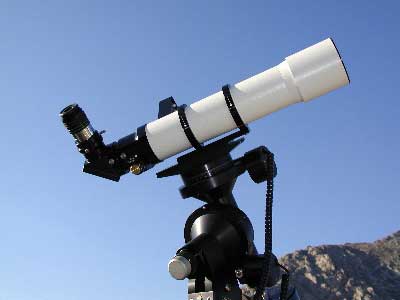
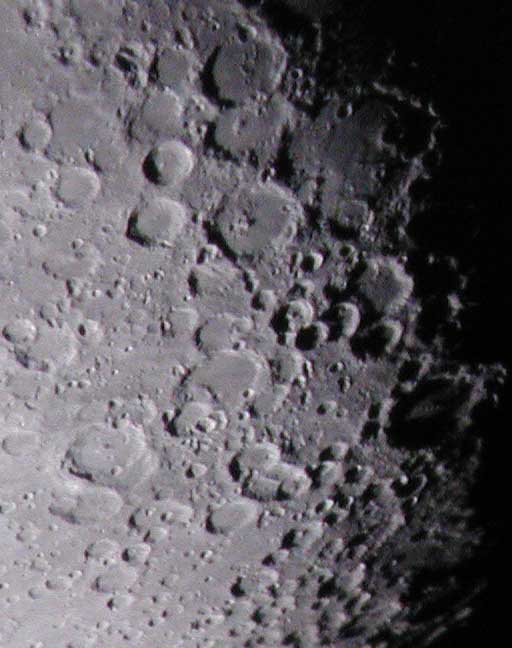
 155mm EDT (photo by Jay Ouellet)
155mm EDT (photo by Jay Ouellet)